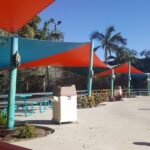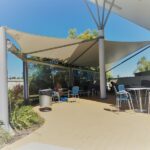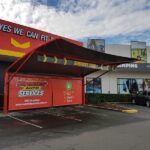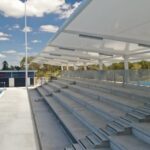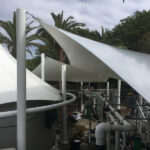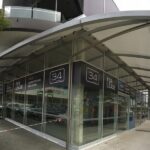Waterproof Shade Structures
YOU ARE HERE:
High-quality waterproof shelter for your restaurant, café, deck, pergola, driveway, carport and more
Many of our customers consider waterproof shade sails as a cost-effective alternative to building roofing onto existing buildings. Our waterproof shade sails are architecturally designed with an aesthetic shape that seamlessly integrates with surrounding structures and landscapes of your environment.
PVC Tension Membranes
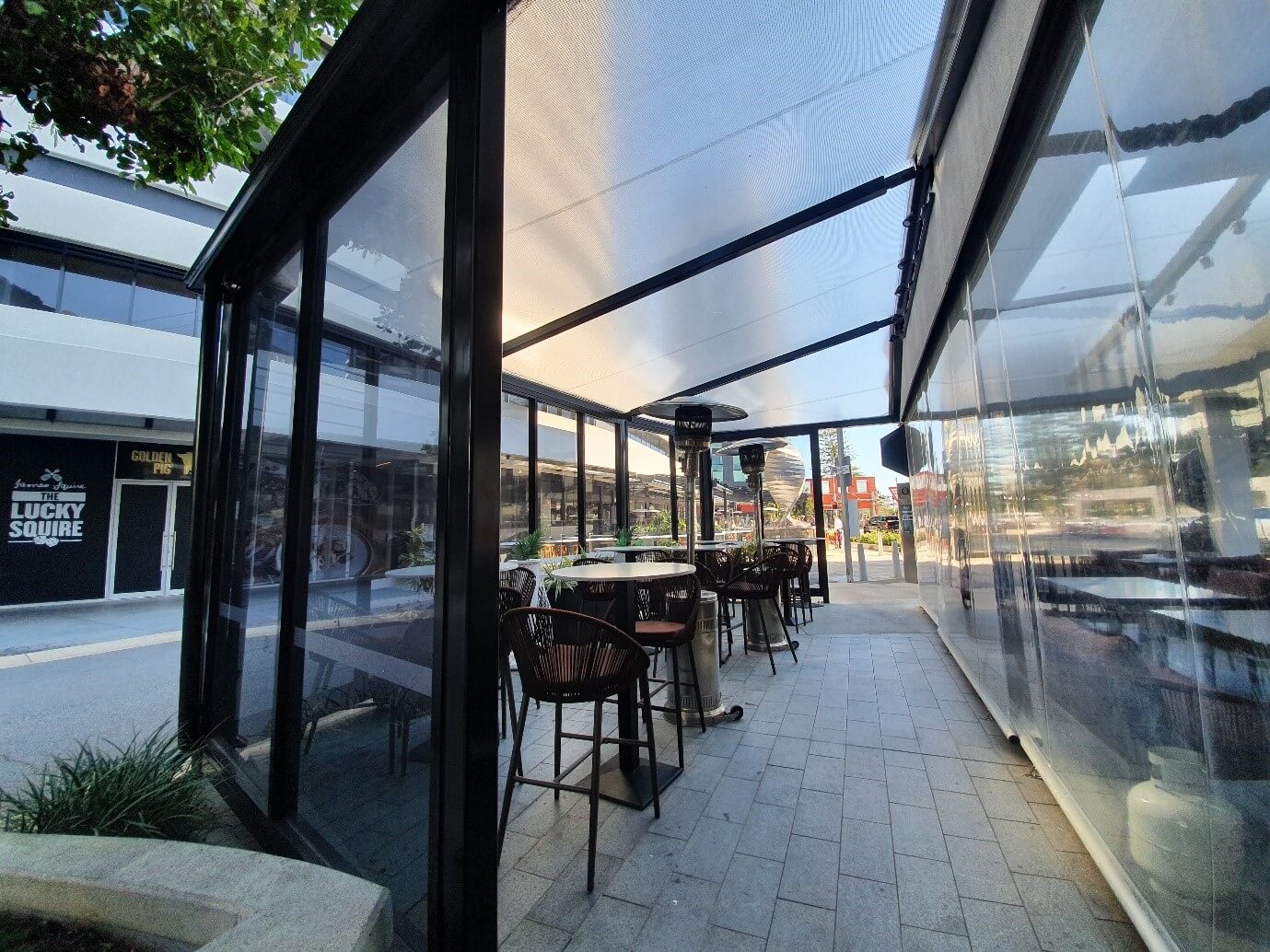
Our PVC tension membranes offer a completely waterproof shade sail solution creating a wonderful shade feature that looks great and blends into your restaurant, outdoor dining, café, or outdoor business area no matter what the weather. You and your customers will enjoy 100% shade and rain protection all year round.
Custom design
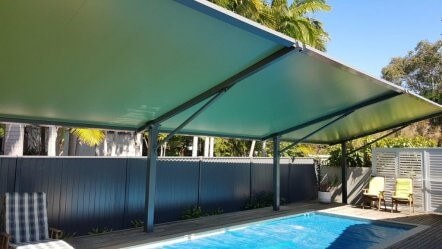
We specialise in custom designed and engineered high-quality outdoor waterproof shade solutions for commercial buildings like shopping centres as well as, childcare centres, schools, and landscape areas, as well as high-end residentials. Our waterproof shade sails are made from the highest quality PVC membranes and are guaranteed to provide quality UV protection, durability and strength for long-term waterproof shelter and shade.
Waterproof Shade Structures vs Shade sail structures
As the name suggests, a waterproof shade structure offers both protection from rain as well as UV protection, while a shade structure only provides UV protection. The main difference between the two options is the specialist fabric used overhead. If you are unsure which option more accurately meets your needs, learn more here about the differences between waterproof shade structures and shade sail structures
Colours
There are a range of different waterproof shade fabrics, and each type has various qualities as well as an array of colours. For instance the Serge Ferrari Precontaint satin range has a 100 colours to choose from.
Similarly the steel fabrication is powder coated and there are a plethora of colours to choose from as you can see from Interpon’s industrial design colour range. These colour options are just a taste of your available colours. There are many more giving you the opportunity to get the exact colour combination for your waterproof shade project.
Waterproof shade structure environments
Waterproof shade sails and waterproof structures are ideal for:
- Over swimming pools
- Outdoor dining areas like restaurants and cafés
- Over pergolas, decks, or patios
- BBQ areas
- Courtyards and backyard areas
- Playgrounds in schools, childcare centres
- Council parks
- Bus stops
- Carparks and driveways
- Sporting facilities
- And much more!
Material used
Besides using the best waterproof shade fabrics and powder coating, we use Australian made galvanised steel posts which are over-engineered. We also use footings that meet or exceed building codes to ensure that our waterproof shade sail structures do not fail.
Our team has years of experience helping hundreds of clients install waterproof shade structures that will meet your needs and look fantastic.
- Serge Ferrari Soltis
- Precontraint 782 S2
- Precontraint 832 S2
- Precontraint 902 S2
- Precontraint 1002 S2
- Precontraint TX30
- Soltis 86
- Verseidag
- Hiraoko
- Melher Valmex FR580
- Mehler Mehatop F1
Australian made
Our commercial umbrellas are proudly Australian made in Brisbane. We use the best materials possible to ensure durability.
Licensee ID number: 15969
Awards
We have won numerous national awards for both domestic and commercial waterproof shade structures over the last five years. Our awards are in recognition of the challenging environments we have installed shade structures in, as well as the custom designs that were required for the various environments.
Versatile Structures can deliver a complete design and construction solution, including all Building approvals, engineering requirements, Project Management, Installation, and commissioning of electrical aspects, in either Shade cloth or Waterproof PVC Membrane options. Let us know your specific requirements and we will advise how we can best assist you with your project.
Projects
- Habitat on Juers
- KFC Kangaroo Point
- Pimpama State School
- St Rita’s College
- Cook Medical
- Pool Membrane
- Mecca Bah
- Waterside Gold Coast
Waterproof shade structure articles
- Commercial waterproof shade structure for business
- Protect your business with waterproof shade sails
- The top 5 things to consider when buying a waterproof shade structure in Brisbane
- Waterproof shade sail questions you may have
- Everything you need to know about commercial shade structures
- Waterproof shade structures vs shade sail structures
FAQ
Yes, our waterproof shade sails are designed to withstand various weather conditions including rain, wind, and sunlight. They are made from durable materials that are resistant to tearing and fading.
The lifespan of our waterproof shade sails depends on factors such as the quality of installation, maintenance, and exposure to elements. However, with proper care, they can last up to 10 years or more. Warranties start from minimum 10 years and up to 20 years warranty. However the lifespan of the structure, if maintained correctly, could last up to 30 years + before the membrane skin could need replacement.
Absolutely, our shade sails are highly customizable to fit any space or shape. We offer a range of sizes, shapes, and colours to suit your specific requirements.
While our shade sails are low maintenance, it’s recommended to clean them periodically to remove dirt and debris. Additionally, inspecting them for any signs of wear and tear can help prolong their lifespan
Not at all! Our experienced team handles the installation process efficiently and professionally. We ensure that the shade sails are securely installed to withstand the elements.
Yes, our shade sails are designed to block harmful UV rays, providing protection for you and your outdoor furniture. They offer excellent shade coverage while reducing the risk of sunburn and UV-related skin damage.
Absolutely, our shade sails are versatile and suitable for both residential and commercial applications. Whether you need shade coverage for your backyard, patio, or commercial property, we have solutions to meet your needs.
Yes, we stand behind the quality of our products. Our waterproof shade sails come with a warranty to provide you with peace of mind and assurance of their durability.
Our shade sails are made from high-quality materials that are eco-friendly and sustainable. They are designed to withstand the elements without causing harm to the environment.
While our shade sails are designed to withstand various weather conditions, some customers prefer to remove them during the winter months for added protection. Our team can assist with the removal and reinstallation process as needed.
The amount of fall or slope required for a waterproof shade sail depends on several factors, including the type of sail, the desired functionality, and local weather conditions. Here are some general guidelines:
Minimum Slope: A minimum slope of 10-15 degrees (or 2-3 inches of fall per foot) is often recommended for waterproof shade sails. This slope helps water drain off the sail and prevents water from pooling, which can lead to damage or sagging of the fabric.
Local Weather Conditions: The amount of slope needed may vary depending on your location and the average rainfall. Areas with heavy rainfall may require a steeper slope to ensure effective water drainage.
Type of Fabric: The type of fabric used in the shade sail can also influence the required slope. Some waterproof fabrics may require a steeper slope than others to effectively shed water.
Installation: The way the shade sail is installed can affect its ability to shed water. Proper tensioning and installation can help ensure that water runs off the sail as intended.
Design and Aesthetic Preferences: The desired look and design of the shade sail can influence the amount of fall you choose. Some people may prefer a steeper slope for aesthetic reasons, while others may prioritise functionality.
It’s important to consult with a professional or follow the manufacturer’s guidelines when installing a waterproof shade sail to ensure that it is installed with the appropriate amount of fall for your specific situation.
Yes—they are designed for all-weather use. Waterproof shade sails deliver continuous shelter from sun and downpours, offering a practical solution for extended outdoor use. They even help maintain usability during rain, whether it’s light showers or torrential downpours.
- PVC-coated membrane fabrics (e.g., Serge Ferrari, Mehler brands) provide 100% waterproof properties and are flexible and strong.
- PTFE (Polytetrafluoroethylene) woven fibreglass membrane, which is both waterproof and highly UV- and wind-resistant.
- They also use Australian-made galvanised steel posts and powder-coated steel frameworks engineered for high resistance to weather stresses and long-term durability.
